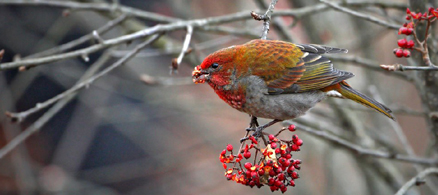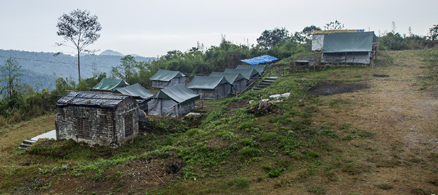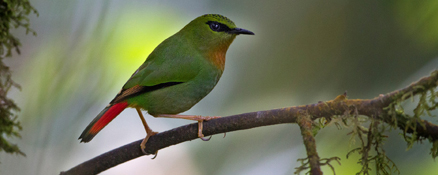10 Best forest reserves in India to see iconic Hornbill

What is the Hornbill?Hornbills are large, colourful birds known for their long, curved bills and dramatic casques. India is home to nine hornbill species, including the iconic Great Hornbill, Malabar Pied Hornbill, and the endangered Rufous-necked Hornbill. Revered in tribal folklore and critical to forest ecology as seed dispersers, hornbills are often spotted in dense, tropical forests, especially during nesting season when their calls echo through the canopy. Here are the 10 best forest reserves in India to see the iconic Hornbill: (Image credit: Canva)

2/10
1. Pakke Tiger Reserve, Arunachal PradeshOne of India’s best hornbill conservation sites, Pakke is home to four species, including the endangered Rufous-necked Hornbill. The Hornbill Nest Adoption Programme here helps protect nesting trees and offers guided hornbill-watching treks. (Image credit: Canva)

3/10
2. Namdapha National Park, Arunachal PradeshIndia’s easternmost park is a hornbill haven. Dense canopies, elevation diversity, and low human disturbance allow multiple species like the Wreathed and Great Hornbill to thrive. Jungle camps offer the best chances of spotting them. (Image credit: Canva)

4/10
3. Dandeli Wildlife Sanctuary, KarnatakaThe forests of Dandeli are famed for the Malabar Pied and Malabar Grey Hornbills. Early morning and evening boat rides along the Kali River offer superb viewing of hornbills flying across the treetops or calling from fig trees. (Image credit: Canva)

5/10
4. Silent Valley National Park, KeralaThis untouched Western Ghats rainforest hosts the Great Hornbill and Malabar Grey Hornbill. A biodiversity hotspot, Silent Valley’s silent, misty forests amplify the hornbill’s distinctive call, offering a truly immersive birdwatching experience. (Image credit: Silent Valley National Park)

5. Nameri National Park, AssamLocated near the Bhutan border, Nameri is another great site to see the Wreathed and Great Hornbills. Its riverine forests and open patches near the Jia-Bhoreli River provide ideal feeding and nesting habitats for these iconic birds. (Image credit: Canva)

7/10
6. Khangchendzonga National Park, SikkimIn the higher eastern Himalayas, this UNESCO World Heritage Site is home to the rare Rufous-necked Hornbill. Though elusive, sightings are possible during the summer when the birds descend to lower altitudes for feeding. (Image credit: Canva)

7. Bhagwan Mahaveer Sanctuary, GoaA surprising hornbill destination, this Western Ghats forest shelters the Malabar Pied and Malabar Grey Hornbills. Trekking trails through Mollem forest often echo with their loud wingbeats and vocalisations during the fruiting season. (Image credit: Canva)

9/10
8. Periyar Tiger Reserve, KeralaLocated in Thekkady, Periyar offers opportunities to see the Great Hornbill soaring above the canopy. Boat rides on the lake and guided forest walks help spot hornbills near nesting trees along forest fringes. (Image credit: Canva)

10/10
10. Buxa Tiger Reserve, West Bengal :This forest near the Bhutan border is known for Oriental Pied and Great Hornbills. Its mix of riverine and evergreen forests provides year-round hornbill habitat. Guided safaris from Jayanti village increase your chances of sightings. (Image credit: Canva)
India, a land of incredible biodiversity, is home to nine spectacular species of hornbills. These large, charismatic birds, with their oversized casques and dramatic bills, play a crucial role in their forest ecosystems as seed dispersers, earning them the moniker “farmers of the forest.” From the foothills of the Himalayas to the lush rainforests of the Western Ghats, several protected areas offer bird enthusiasts the incredible opportunity to witness these magnificent creatures in their natural habitat. Here are the 10 best forest reserves in India to see the iconic hornbill:
Northeast India: A Hornbill Hotspot northeast India is a veritable paradise for hornbill lovers, with several reserves boasting the presence of multiple species.
1. Pakke Tiger Reserve, Arunachal Pradesh
Pakke Tiger Reserve is located in the East Kameng district of Arunachal Pradesh. It is surroundedby the Tenga Reserve Forest to the North, Doimara Reserve Forest on the West, Nameri National
Park and Tiger Reserve (Assam) on the South and some agricultural land as well as Papum Reserve
Forest on the East. The landscape has high species diversity and endemicity as it forms thetransition zone between the Indian and Malayan eco-regions. The two important parts of the North-
East Indian tiger landscape are the Brahmaputra flood plains and the North-East Indian hills.
Pakke and Nameri Tiger Reserves are situated North of the river Brahmaputra in the transition zone between the Assam plains and the hilly forests of Arunachal Pradesh. Together, they form one of the largest blocks of semi-evergreen and evergreen forests in the North-East. They are extremely
important in maintaining contiguity within the North-East Indian forests and are centrally located
within the Western Assam and Arunachal forests. On the West, they are connected with Sonai-Rupai
Wildlife Sanctuary through Sessa Orchid Wildlife Sanctuary and Eaglenest Wildlife sanctuary, onthe South with Kaziranga Tiger Reserve and Karbi-Anglong hills, and towards the North, they are contiguous with Tale valley and Lower Subansiri forests, which are contiguous with East – Siang and further into Namdapha Tiger Reserve in Changlang district in eastern Arunachal Pradesh.
Area of the tiger reserve
Core/critical tiger habitat : 861.95 Sq. Km
Buffer/Peripheral area : 515.00 Sq. Km.
Total : 1276.95 Sq. Km
Location
Latitudes : 270
01’ 05’’ N to 270
11’ 05’’ N
Longitudes : 920
39’ 05’’ E to 920
44’ 20’’ E 2
Habitat Attributes
Flora :The main vegetation type of the entire tract is Assam Valley tropical semi-evergreen forest. At places, evergreen and semi-evergreen vegetation types merge. The forests are multi-storied and rich
2. Namdapha National Park, Arunachal Pradesh
Overview
Namdapha National Park is a biodiverse protected area located in the easternmost part of Arunachal Pradesh. It is situated in the foothills of the Himalayas and covers an area of around 1,985 square kilometres, making it the largest protected area in the Eastern Himalayan Biodiversity Hotspot. It is one of the few remaining areas in India where the critically endangered Hoolock Gibbon is found. The park is also home to the Bengal tiger, clouded leopard, Indian leopard, snow leopard, and several species of deer and antelope.
FAQs – Frequently Asked Questions about Namdapha National Park
How do you plan for the perfect trip to any destination?
To plan the perfect trip, the following will help cover any caveats for your to arrive at the best plan for your vacations :Where do you want to go? – Your first step in how to plan a vacation is to choose a travel destination that meets your interests and travel budget.Once you have chosen your destination, the next step in planning a trip is to book flights. And learning how to find and book cheap flights will help you reduce one of your biggest expenses when it comes to travellingWhere you stay is your other major travel expense, so choosing the best stay for your needs at a price that suits you will free up more money for activitiesAnother major thing to consider while planning a trip is to find out the transportation options in your chosen destination, be it public or private and the costs involvedWhen you plan a trip you should also research about the must-visit attractions and the best free things to do in your destination of choiceKnow the visa requirements for visiting the destinationDepending on where you are planning your trip in a particular country, it’s important to get the correct advice for any necessary vaccinations that needs to be taken care of before your travel datesMake copies of your important documents and keep them handy
How to choose a destination to travel to?
Travelling is exhilarating – and a little bit intimidating too. You are venturing into the unknown and you really have very little ideas about what things will be like there when you arrive. It’s always a massive learning curve when you leap into the new (which is why it’s important to thoroughly research a travel destination before you go.) Some of the important things to keep in mind while deciding on a destination to travel are :Figure out how to travel to a destination, where to stay and what are the things to do amongst other things. Trip Ideas by MakeMyTrip brings you a plethora of knowledge about a destination ranging from images and videos to lists of all the Activities read posts by travel bloggers who have been there and if needed email Then watch documentaries and reach out to people who have been there
How to explore a place by yourself?
“Adventure is out there!” – You just need to know the ‘whats’ and the ‘hows’ of it. You need to realize the things that will make exploring a place completely worthwhile and satisfy all of your travel cravings. This can be achieved by -Taking Yourself Out To Eat At A Restaurant learn The Public Transportation Route check Out A Local Planetarium Or Observatory take A Drive To The Nearest Coastal Town Or National Park join A Group Of Tourists On A Sightseeing Tour take Pictures At A Botanical Garden go Shopping At A Local Farmers Market
Citizen-science initiative celebrating Indian Hornbills
Hornbills are crucial to the maintenance of forests, especially highly bio-diverse regions like the Western Ghats and Eastern Himalayas. Encouraging citizens to document hornbill sightings will fill gaps in knowledge about their occurrence and distribution, and aid long- term conservation efforts.
Hornbills as charismatic species
Hornbills, with their disproportionately large beaks and the casques that adorn them, are among the more easily identifiable birds in the landscapes they occupy, be it a forest in Arunachal Pradesh or a park in a crowded metropolis like New Delhi. Their plumage is made up of contrasting colours, and some species have brightly coloured patches of loose skin on their throats. However these birds aren’t just charismatic in appearance: Famously dubbed the ‘Farmers of the Forest’, these frugivores help in seed dispersal of several endemic trees and are important for survival and upkeep of entire forests.
Public engagement in hornbill conservation
On the occasion of World Environment Day in 2014, Nature Conservation Foundation (NCF) and Conservation India (CI) launched Hornbill Watch (www.hornbills.in), a citizen-science initiative to better understand Indian hornbills, the iconic forest birds that are fast disappearing along with their tropical forest habitat in India and other Asian countries. Hornbill Watch provides the spotlight on these species and allows users to contribute towards increasing our understanding of hornbill distribution and their conservation by sharing hornbill sightings and images.
Hornbills in India
India is home to nine species of hornbill: The Great Hornbill, Rufous-necked Hornbill, Wreathed Hornbill, Narcondam Hornbill, Malabar Pied Hornbill, Oriental Pied Hornbill, White-throated Brown Hornbill, Malabar Grey Hornbill, and the Indian Grey Hornbill. The Great hornbill is the largest species in the country. Five species are found in the north- eastern states of which the Wreathed hornbill, Rufous-necked hornbill and the White- throated brown hornbill are restricted to this region within India, although they have a wider distribution in South-east Asia. The Narcondam hornbill is found only on Narcondam island in the Bay of Bengal. The Indian grey hornbill occurs in the Indian sub-continent, while the Malabar Pied hornbill is found only in India and Sri Lanka, and the Malabar grey hornbill is endemic to the Western Ghats.
Hornbill Watch – how does it work?
Hornbill Watch is a website where anybody can share details of a hornbill sighting from anywhere in India. Entry submission is quick and simple since contributors can send in their records without having to log in or register. This website can be used by people from all backgrounds. Being a wildlife conservationist or photographer, or even an avid birder, is not a necessity. One can find information on Asian hornbills in general, and detailed descriptions of the nine species found in India by way of short accounts pertaining to their distribution and evolution, diet and conservation status. Moreover, the gallery contains stunning photographs of hornbills and record shots of interesting behaviours that have been sent in by other contributors. Posting a record is easy! One has to provide details of the species sighted, numbers seen, approximate location and, if possible, other demographic information such as the age or sex of the bird and the behaviour exhibited. All images are credited to the contributor. The uploaded images appear immediately in the gallery section and can be shared socially through the integrated Facebook plugin. The data generated is summarized, analyzed and shared on the website periodically. A detailed report will be available to all contributors. Click here to upload right away: http://hornbills.in as well as read more about hornbills.
How does this help us?
While there are several limitations to the conclusions and inferences we may draw from the records submitted to Hornbill Watch, they provide important information that is worth exploring in terms of hornbill occurrence. For example, records show that the Indian grey hornbill is found in public parks or degraded land in highly developed cities like Bangalore, Mumbai and Hyderabad, which points to the adaptability of the species. Records also show that several other hornbill species occur in areas outside Protected Areas and provides new information on their occurrence at sites across the country. This information can augment our understanding of their distribution, serving as a baseline to examine long-term changes and trends. It also helps identify important nesting and roosting sites. Over time, the data collected would help in identifying and prioritizing sites for hornbill conservation. Hornbill Watch provides a wealth of information about the natural history of hornbills seen around the country, unique behaviours observed, and the habitats and landscapes they have adapted to. The most attractive feature of the website is a gallery that is filled with remarkable photographs submitted by our contributors. The project was initiated through a grant from the Whitley Fund for Nature, UK.
Mahananda Wildlife Sanctuary
Mahananda Wildlife Sanctuary is situated in the Darjeeling district of West Bengal.
By Vajiram Editor – Aug 29, 2023, 06:08 IST
Share
Follow Us
Table of Contents☰
About Mahananda Wildlife Sanctuary
Location:
It is situated in the Darjeeling district of West Bengal.
It is located on the foothills of the Himalayas and in between the Teesta and the Mahananda rivers.
It was started as a game sanctuary for children in 1955. In 1959, it got the status of a sanctuary mainly to protect the Indian Bison and Royal Bengal Tiger.
The Sanctuary reaches up to a high elevation at Latpanchar in Kurseong Hill.
Terrain: The terrain is undulating, with moderate to steep slopes and high ridges towards the north.
Vegetation: It varies mainly from riverine forests to dense mixed-wet forests due to the difference in altitude.
Flora:
Mainly, Sal, Shisu, Teak and Jarul forests are available here.
Other plantations include Udal, Champ, Lali, Jarul, Gamar, Mandane, Bamboos, Ferns, Orchids, Sidha etc.
Fauna:
The important mammalian species include the Royal Bengal Tiger, Indian elephants, Indian bison, spotted deer, barking deer, many species of lesser cat, Himalayan black bear etc.
The Sanctuary also holds hundreds of feathered species. It includes endangered species like fairy blue bird, Himalayan pied hornbill, etc.
Q1) What are riverine forests?
Riverine forests, also known as riparian forests or floodplain forests, are ecosystems found along the banks and floodplains of rivers and streams. These forests are characterized by their unique ecological features, which are influenced by the periodic flooding and flowing water of nearby rivers…. Read more at: https://vajiramandravi.com/current-affairs/mahananda-wildlife-sanctuary/
Eagle’s Nest Wildlife Sanctuary Arunachal Pradesh
Eagle’s Nest Wildlife Sanctuary -(An unlimited treasure cove in terms of both birds and wildlife) is a protected area in Himalayan foothills located in west kameng district in Arunachal Pradesh. Eagle’s nest Wildlife Sanctuary acquired its name from the Indian army regiment named “Eagle” stationed there years ago. One can see the abandoned military posts almost in ruins scattered along the road in the sanctuary. The road descends from highest point in the track Circa at 2900 m (Eagle nest pass to lama camp) northern border of the sanctuary to Brahmputra plains in the south & Sunderview, Bompu, sessni are the camps lying in the lower altitude. There is a jeep track passing through temperate cloud forest, dense strands of bamboo & patches of broadleaved evergreen forest covering large altitudinal range.
Eagle Nest’s Wildlife Sanctuary prime draw is that it is considered amongst the topmost birding destinations in the World -a birding paradise ( some species found nowhere else in the country) with the checklist growing faster than the expectations of the birding enthusiasts. A unique feature of this sanctuary is that within itself the entire elevational range is covered containing all habitats and species. There is wealth of learning with the abundance of birds and wildlife in this zone free of noise with pristine woods.
There is abundance of bird species -about two dozen babbler, more than 20 types of warbler, sunbirds, flycatchers (ultramarine, slaty blue, white gorgeted,sapphire, dark sided), variety of woodpeckers, laughing thrush etc. Above all, a glimpse of Bugun liocichla ( new species to science recently discovered), Ward’s tragon, Mrs. Gould’s sunbird not only uplifts the mood but is considered a highlight in any bird watcher’s checklist. Winter’s in Eaglenest with lush evergreen forests & stunning landscapes is spectacularly beautiful. One encounter’s birds like tawny wood owl, grey chinned minivet, mountain hawk eagle, Barbets ( 6 species), Partridge ( rufous throated & chestnut breated), Robin( golden bush & blue fronted), niltava, fulvettas, parrotbills ( 4 species) .
It is important to mention here that this enchanting area is accessible even during monsoon season. Few animals and some birds are visible only during this season.
Mainly targeted birds are Blythe’s & Temincks tragopan, beautiful nuthatch, rufous necked hornbill, shortwings( lesser & white browed), wren babbler( wedge billed), Wards trogon etc.
Eagle’s nest Wildlife Sanctuary is not only an exotic experience in birding but is also a photographer’s delight . Pictures of some rare birds, butterflies and mammals can be quite exhilarating. It is also home for many species of amphibians, snakes & lizards, mammal species like Bengal Tiger,Clouded leopard, Red Panda, Arunachal Macaque, Gaur & endangered capped Langur. More than 160 species of butterflies have been recorded. It is truly a magical & mysterious land as one never knows what they may encounter during their visit because so much is yet to be explored. The rediscovery of Mictopholis ( Lizard species) after 130 years and the discovery of the Litter frog in Bompu region ( new species to science) recently in the year 2009 is testimony to this.

BIRDS OF MANDALA SELA PASS

BOMPU BIRDING CAMP

MANDALA BIRDING LODGE

Fixed Departure Tour
Special Offer for 2022-23

BIRDS OF NORTH EAST
600+ Bird Species and much more
Reading this is akin to walking through a quiet landscape, where each sentence illuminates nuance, evokes emotion, and encourages deliberate attention, reflection, and a meditative appreciation of the text.